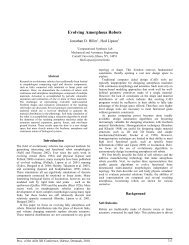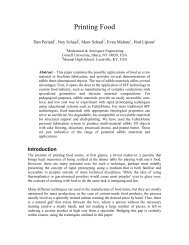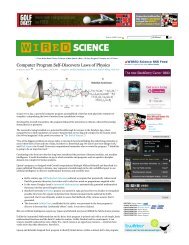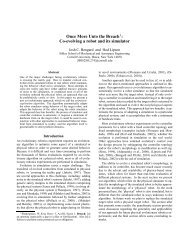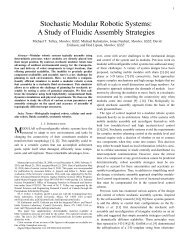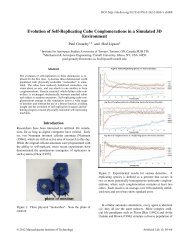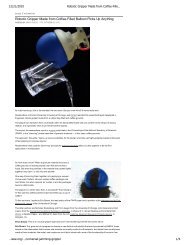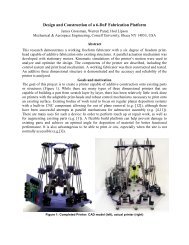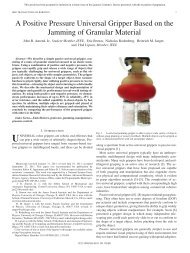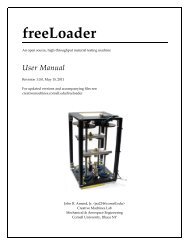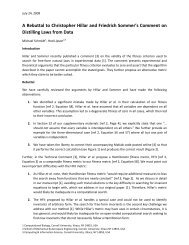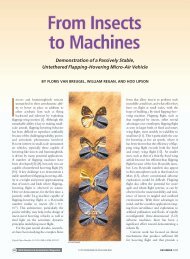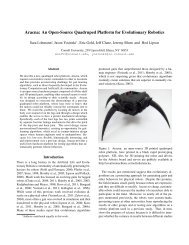Multi-material Freeform Fabrication of Active Systems - Cornell ...
Multi-material Freeform Fabrication of Active Systems - Cornell ...
Multi-material Freeform Fabrication of Active Systems - Cornell ...
You also want an ePaper? Increase the reach of your titles
YUMPU automatically turns print PDFs into web optimized ePapers that Google loves.
3.2. Wiring, Circuit Boards, Strain Gages, &<br />
Electromagnets<br />
An essential functionality for any electromechanical device<br />
is electrical circuitry – wiring. We have developed two<br />
approaches to freeform fabrication <strong>of</strong> wiring, based on two<br />
types <strong>of</strong> <strong>material</strong>s, each with particular benefits and drawbacks.<br />
The first class <strong>of</strong> <strong>material</strong>s could be described as<br />
conductive composites, e.g. polymers filled with a granular<br />
conductive phase. These include commercially available silver<br />
inks, our own ink formulations, and silver-filled silicone<br />
rubber. These <strong>material</strong>s have the benefit <strong>of</strong> simple, roomtemperature<br />
processing, and are typically flexible, or even<br />
elastic, but the drawback <strong>of</strong> having relatively high resistivity –<br />
typically ~ 10 -3 Ω-cm. Their “s<strong>of</strong>t” nature immediately<br />
suggests novel applications beyond simple wiring. Figure 4<br />
shows a freeform fabricated functional, flexible printed circuit<br />
board comprising Ag-filled silicone traces embedded in<br />
insulating silicone. Figure 5 shows how with a simple change <strong>of</strong><br />
the CAD model sent to the SFF system, the same combination<br />
<strong>of</strong> <strong>material</strong>s can be configured as a functional strain gage.<br />
(a) (b)<br />
Figure 4. A two-dimensional flexible printed circuit: (a) as fabbed<br />
(dimensions in centimeters); (b) with components inserted and<br />
power supplied.<br />
(a) (b)<br />
Figure 5. (a) A silver-filled silicone strain gage (dimensions in<br />
mm); (b) resistance vs. strain data over 100 cycles.<br />
The second class <strong>of</strong> <strong>material</strong>s is fusible metals which have<br />
low melting points, such as alloys <strong>of</strong> Pb, Sn, Bi, Sb, or In.<br />
These <strong>material</strong>s <strong>of</strong> course require elevated-temperature<br />
processing, but have the benefit <strong>of</strong> very high conductivity –<br />
typically ~ 10 -5 Ω-cm. By careful tuning <strong>of</strong> deposition<br />
parameters, we have achieved continuous deposition <strong>of</strong> Sn-Sb<br />
alloy strands 0.5mm in diameter and more than 5m long. This<br />
combination <strong>of</strong> high conductivity and fine gage has enabled us<br />
to freeform fabricate coils <strong>of</strong> sufficient density and number <strong>of</strong><br />
turns to produce functional electromagnets (Figure 6). Our best<br />
result so far has been three consecutive stacked layers <strong>of</strong> 20<br />
turns each at about 1 turn/mm <strong>of</strong> radius. To amplify the<br />
magnetic field, we have employed a core <strong>material</strong> consisting <strong>of</strong><br />
80wt% iron filings in lithium grease, which is readily deposited<br />
via the syringe deposition tool.<br />
(a) (b)<br />
Figure 6. <strong>Freeform</strong> fabrication <strong>of</strong> an electromagnet: (a) depositing<br />
multiple layers <strong>of</strong> Sb-Sn alloy wire coils atop a freeform fabricated<br />
silicone base via the molten-extrusion tool; (b) a complete<br />
electromagnet assembly.<br />
3.3. Electroactive Polymer Actuators<br />
Rotary electromagnetic motors are the dominant form <strong>of</strong><br />
electromechanical actuator in the world today. Despite our<br />
success with electromagnets, which are a key subsystem <strong>of</strong><br />
rotary motors, freeform fabrication <strong>of</strong> a complete rotary<br />
electromagnetic motor remains a “grand challenge” for SFF<br />
due to the complexity <strong>of</strong> moving coils, bearings, etc.<br />
Fortunately, electromechanically active <strong>material</strong>s exist which<br />
can be configured as mechanical actuators in a relatively simple<br />
fashion. We have investigated a particular type <strong>of</strong> device,<br />
known as an Ionomeric Polymer-Metal Composite (IPMC)<br />
Actuator, which typically comprises two or three <strong>material</strong>s, and<br />
which bends in response to a low voltage electrical signal. We<br />
adapted the IPMC solution-processing research <strong>of</strong> Kim and<br />
Shahinpoor [20] by formulating <strong>material</strong>s compatible with SFF<br />
processes, and developed the technique <strong>of</strong> fabricating the<br />
container for the actuator <strong>material</strong>s along with the actuator – a<br />
key innovation which enables actuators to be embedded within<br />
more complicated freeform fabricated devices. Using these<br />
innovations, we have successfully demonstrated freeform<br />
fabrication <strong>of</strong> complete IPMC actuators, and documented the<br />
longest reported operating life in air for IPMCs manufactured<br />
by any method [21]. As with batteries, however, freeform<br />
fabricated IPMCs have inferior performance in several metrics<br />
– blocked stress, bandwidth, and range <strong>of</strong> motion – to those<br />
produced by established laboratory methods. We are continuing<br />
4 Copyright © 2008 by ASME



